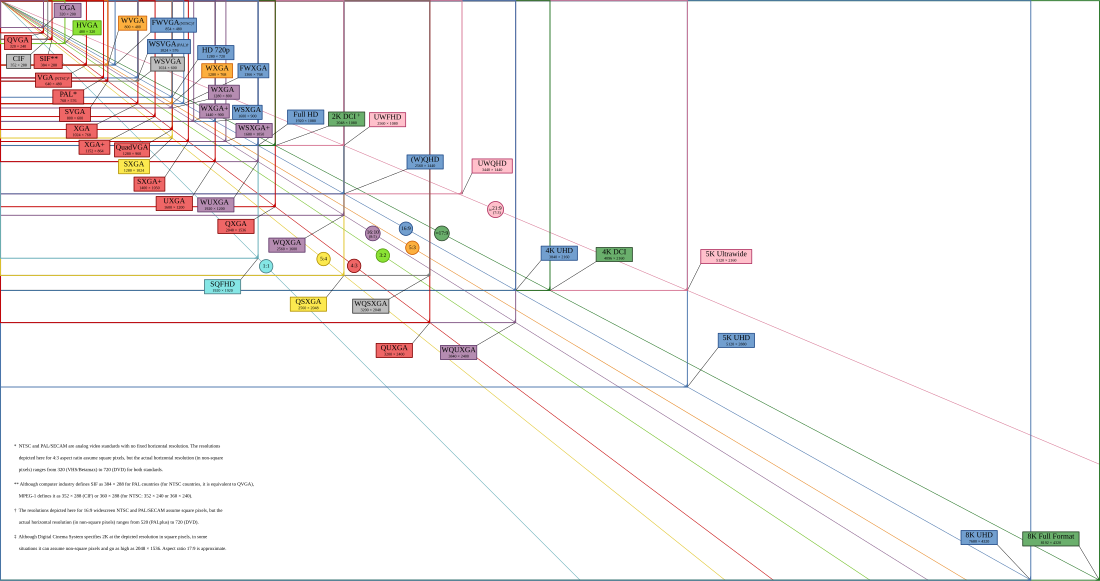Top Qs
Timeline
Chat
Perspective
Ultrawide formats
Photo and video display formats From Wikipedia, the free encyclopedia
Remove ads
Ultrawide formats refers to photos, videos,[1] and displays[2] with aspect ratios greater than 2. There were multiple moves in history towards wider formats, including one by Disney,[3] with some of them being more successful than others.
This article needs additional citations for verification. (June 2023) |

Cameras usually capture ultra-wide photos and videos using an anamorphic format lens, which shrinks the extended horizontal field-of-view (FOV) while saving on film or disk.[4]
Remove ads
Historic Ultrawide Cinema
Historically ultrawide movie formats have varied between ~2.35 (1678:715), ~2.39 (1024:429) and 2.4. To complicate matters further, films were also produced in following ratios: 2.55, 2.76 and 4. Developed by Rowe E. Carney Jr. and Tom F. Smith, the Smith-Carney System used a 3 camera system, with 4.6945 (1737:370) ratio, to project movies in 180°.[5] Disney even created a 6.85 ratio, using 5 projectors to display 200°. The only movie filmed in Disney's 6.85 ratio is Impressions de France.[3]
Remove ads
Wide aspect ratios
Suggested by Kerns H. Powers of SMPTE in USA, the 16:9 aspect ratio was developed to unify all other aspect ratios. Subsequently it became the universal standard for widescreen and high-definition television.
Around 2007, cameras and non-television screens began to switch from 15:9 (5:3) and 16:10 (8:5) to 16:9 resolutions.
Extra-wide aspect ratios
Univisium is an aspect ratio of 2:1, created by Vittorio Storaro of the American Society of Cinematographers (ASC) originally intended to unify all other aspect ratios used in movies.
It is popular on smartphones and cheap VR[clarification needed] displays. VR displays halve the screen into two, one for each eye. So a 2:1 VR screen would be halved into two 1:1 screens. Smartphones began moving to this aspect ratio since late 2010s with the release of Samsung Galaxy S8, advertised as 18:9.
Ultra-wide aspect ratios
Summarize
Perspective
21:9 is a consumer electronics (CE) marketing term to describe the ultra-widescreen aspect ratio of 64:27 (211⁄3:9) = 1024:432 for multiples of 1080 lines. It is used for multiple anamorphic formats and DCI 1024:429 (21.482517:9), but also for ultrawide computer monitors, including 43:18 (211⁄2:9) for resolutions based on 720 lines and 12:5 (213⁄5:9) for ultrawide variants of resolutions based either on 960 pixels width or 900 lines height.
The 64:27 aspect ratio is the logical extension of the existing video aspect ratios 4:3 and 16:9. It is the third power of 4:3, whereas 16:9 of widescreen HDTV is 4:3 squared. This allows electronic scalers and optical anamorphic lenses to use an easily implementable 4:3 (1.33) scaling factor.
21:9 movies usually refers to 1024:429 ≈ 2.387, the aspect ratio of digital ultrawide cinema formats, which is often rounded up to 2.39:1 or 2.4:1
Ultrawide resolution can also be described by its height, such as "UW 1080" and "1080p ultrawide" both stands for the same 2560×1080 resolution.
Remove ads
Super-wide aspect ratios
Summarize
Perspective
In 2016, IMAX announced the release of films in Ultra-WideScreen 3.6 format,[6][failed verification] with an aspect ratio of 18:5 (36:10).[7] A year later, Samsung and Phillips announced 'super ultra-wide displays', with aspect ratio of 32:9, for "iMax-style cinematic viewing".[8] Panacast developed a 32:9 webcam with three integrated cameras giving 180° view, and resolution matching upcoming 5K 32:9 monitors, 5120x1440.[9] In 2018 Q4, Dell released the U4919DW, a 5K 32:9 monitor with a resolution of 5120x1440, and Phillips announced the 499P9H with the same resolution. 32:9 Ultrawide monitors are often sold as an alternative to dual 16:9 monitor setups and for more inmersive experiences while playing videogames, and many are capable of displaying 2 16:9 inputs at the same time.
32:9 aspect ratio is derived from 16:9 being twice as large. Some manufacturers therefore refer to the resulting total display resolution with a D prefix for dual or double.
Super wide resolutions refers to that with aspect ratio greater than 3.
Ultra-WideScreen 3.6 video never spread, as cinemas in an even wider ScreenX 270° format were released.[10]
Remove ads
4:1 (36:9)
Abel Gance experimented with ultrawide formats including making a film in 4:1 (36:9). He made a rare use of Polyvision, three 35 mm 1.3 images projected side by side in the 1927 film Napoléon.
AT NAB 2019, Sony introduced a 19.2-metre-wide by 5.4-metre-tall commercial 16K display.[11][12] It is made up of 576 modules (48 by 12) each 360 pixels across, resulting in a 4:1, 17280x4320p screen.
Remove ads
Multi-Screen Theaters
Developed by CJ CGV in 2012, ScreenX uses three (or more) projectors to display 270° content,[10] with an unknown aspect ratio above 4. Walls on both sides of a ScreenX theatre are used as projector screens.
Developed by Barco N.V. in 2015, Barco Escape used three projectors of 2.39 ratio to display 270° content, with an aspect ratio of 7.17. The two side screens were angled at 45 degree in order to cover peripheral vision. Barco Escape shut down in February 2018.
Remove ads
Comparison
Remove ads
See also
References
Wikiwand - on
Seamless Wikipedia browsing. On steroids.
Remove ads

